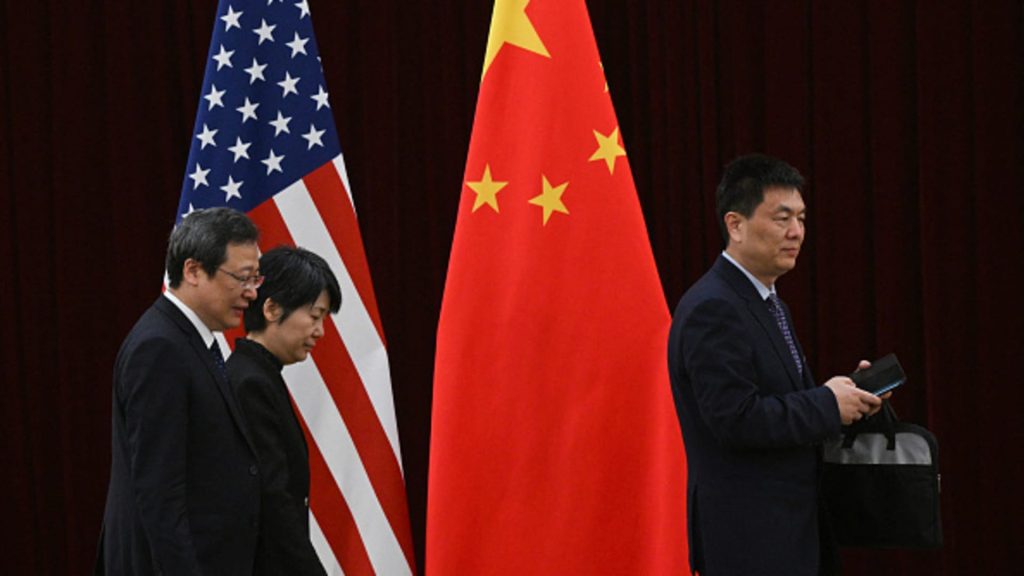In a critical diplomatic engagement, U.S. Treasury Secretary Scott Bessent and Trade Representative Jamieson Greer are set to meet with China’s Vice Premier He Lifeng in Switzerland. The upcoming discussions revolve around trade relations between the U.S. and China, two of the world’s largest economies, as both nations seek avenues for de-escalation amidst mounting economic challenges. Analysts remain doubtful about achieving a comprehensive deal from this single meeting, yet there is optimism for a partial rollback of existing tariffs.
| Article Subheadings |
|---|
| 1) High Stakes for U.S.-China Trade Talks |
| 2) Economic Conditions and Trade Barriers |
| 3) China’s Position and Recent Developments |
| 4) Possible Outcomes of the Meeting |
| 5) Challenges Ahead for Complete Agreement |
High Stakes for U.S.-China Trade Talks
As U.S. and Chinese officials prepare for their significant meeting in Switzerland, the stakes are unmistakably high. This gathering will attempt to moderate tensions that have escalated in recent years. Economic analysts are closely watching the developments, given that the outcome could reshape future relations between these two superpowers. With ongoing tariffs impacting business operations in both nations, the pressure to find common ground is palpable.
Economic Conditions and Trade Barriers
Both the U.S. and Chinese economies face challenges, prompting discussions on trade barriers and tariffs introduced by the Trump administration. The U.S. economy contracted by 0.3% in the first quarter of 2024, with rising inflation and unemployment fueling fears of a recession. Conversely, though China’s economy grew by 5.4% in the same timeframe, forecasts for the remainder of the year have been revised down to approximately 4%, below the government’s target of 5%. Analysts suggest that ongoing tariffs have exacerbated economic pressures in both countries, making negotiations increasingly important.
China’s Position and Recent Developments
China has signaled its readiness for these discussions through a series of strategic maneuvers. Ahead of the talks, it released trade data showcasing an 8.1% year-on-year surge in exports for April, countering declines in shipments to the U.S. Additionally, the Chinese Commerce Ministry initiated a “special operation” to combat the smuggling of essential minerals, which could serve as a strong bargaining chip in negotiations. As the world’s leading producer of minerals critical for technologies like semiconductors, China’s ability to enforce export controls places considerable leverage in its hands.
Possible Outcomes of the Meeting
While a comprehensive deal may be unlikely, analysts anticipate several potential outcomes from this meeting. A partial rollback of tariffs, which currently average around 107%, is considered plausible. Economic experts express hope that these tariffs could be reduced to a terminal rate of approximately 45% by the end of the year. Moreover, both parties may explore the possibility of easing trade restrictions on select goods, alleviating the strain imposed by high tariffs.
Challenges Ahead for Complete Agreement
Despite optimism surrounding the meeting, significant challenges remain. The prospect of reaching a broad agreement akin to the Phase One deal established during Trump’s tenure appears dim. Both the U.S. and China have expressed firm stances regarding their strategic priorities, which complicates potential concessions. Analysts warn that the upcoming talks could be lengthy and fraught with disagreements, potentially leading to unproductive exchanges without substantial progress.
| No. | Key Points |
|---|---|
| 1 | U.S. and China are engaged in critical talks regarding economic relations. |
| 2 | Economic conditions in both countries are increasingly precarious due to tariffs. |
| 3 | China is leveraging its strategic mineral export controls in negotiations. |
| 4 | Analysts predict a potential partial rollback of tariffs by year-end. |
| 5 | Challenges remain for reaching a comprehensive agreement between the two nations. |
Summary
The upcoming meeting between U.S. officials and China’s Vice Premier is a pivotal moment for both nations as they strive to navigate their complex economic relationship. With tariffs impacting economic stability and both countries confronting substantial domestic challenges, the necessity for diplomatic dialogue has never been clearer. While a full agreement may be challenging to achieve, the possibility of partial solutions offers a glimmer of hope for both economies moving forward.
Frequently Asked Questions
Question: What is the significance of the upcoming U.S.-China trade talks?
The trade talks represent a critical opportunity for both nations to address escalating economic tensions and find pathways to alleviate trade barriers imposed by tariffs.
Question: What are some current economic challenges facing the U.S. and China?
Both economies are grappling with growth concerns, with the U.S. experiencing a contraction and China facing downward revisions of its annual growth forecasts.
Question: How might these talks impact future trade relations?
The outcome of these discussions could either help stabilize or further strain U.S.-China relations, depending on the willingness of both parties to seek compromise and ease trade restrictions.
